
GettyImages/Thomas Trutschel
Awesome Fjords in Norway
Avoid the crowds and adventure into the north of Norway. Norway is known for it’s awesome fjords. But what exactly is a fjord? It’s a long, narrow, deep inlet of the sea between high cliffs that formed after several ice ages. Find out where to avoid the crowds and visit these natural wonders on your next adventure.
Most people, when they’re headed to Norway for adventure, opt for Stavangar, the much-photographed port town that’s home to Preikestolen, that social media-famous 604 meter cliff with a flat top.
Fewer tourists look north to Fjaler, a municipality in the county of Sogn og Fjordane, on the shores of Dalsfjorden fjord in western Norway.
And so the towering mountains, ice-cold waters and crisp, clean, air is a venture into Norway’s rugged wilderness and awe-inspiring beauty, without the Instagram-loving crowds.
Even the journey to the region is adventurous; first, a flight to Bergen, an historic city on Norway’s southernmost coast, surrounded by mountains and fjords. Then, hop on the ferry from the Fisketorget – Fish Market – and head to Rysjedalsvika. Two hours later, the boat is met by the Dale or Førde bus, which takes 50 minutes of stomach-churning twists and turns along hairpin roads.

GettyImages/M. SANTINI,DEA
Fjaler itself only has 2,950 inhabitants, while Flekke, one of the region’s smaller villages, has just under 300. The remote nature of the area means there is ample time to explore some of Norway’s most stunning scenery at leisure, without needing to worry about tourist season, and so you can truly immerse yourself in the breathtaking beauty of Scandinavian nature.
Dalsfjorden fjord is a narrow stretch of water, and one of the two main fjords that comprise the Sunnfjord region, known among locals as “home of the waterfalls”. Dalsfjorden is around 40 kilometres (25 miles) long and about 0.5 to 1 kilometre (0.31 to 0.62 miles) wide. The body of water is so still it reflects the sky as if it were a mirror, and its glassy surface is a perfect spot for kayaking.
Hire a boat from GoKajakk and head out to Dalsfjorden, paddle past the twin waterfall Laukelandsfossen, which has an impressive 135 meter drop. During some weather conditions, the waterfall can be up to 100 meters wide. And make sure to keep your eyes peeled for seals. Yndestad and Hovlandsdalsvatnet are both large lakes that are great for canoeing or rowing, and, if you’re feeling really brave, plunge into the icy waters at Flekkefjord.
But the region has much more to offer than just water activities. The pristine fjord is surrounded by tree-clad mountains, which offer an idyllic setting for any hiker. Fossedalen is a perfect area for hiking, with trails running alongside Dalsfjorden, offering panoramic views of the majestic fjord. Hike to Flekke, and take in the idyllic Flekkefjord, a fjord that leads off Dalsfjorden, winding its way through the spectacular hills, forests and valleys of the Dalsfjord valley.

GettyImages/Thomas Trutschel
Eerie and mysterious horizontal potholes at Brufjell lie 20 metres above sea level, and some so big that people can climb inside of them. They were created during the Ice Age more than 20,000 years ago, by rough seas crashing against the rock cliffs.
If your idea of adventure is hunting your own food, then Fjaler is the ideal destination. Numerous lakes and rivers throughout the area are full of trout and salmon. These need a license, but fishing in the fjord is free – as is casting your net out to sea.
If you want to stay out of the towns and stick with nature, but don’t fancy roughing it camping, accommodation option are scarce; a good option is Åmot, a family-run country homestead dating back to 1890, that sits beside a bubbling inlet and at the tip of Dalsfjorden.
Reaching Fjaler is no mean feat. But, the lack of crowds, unspoilt, untouched beauty and fresh, clean air makes it well worth the adventure.


















